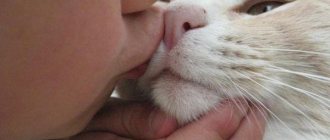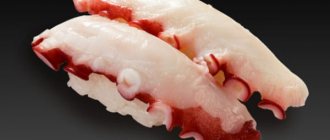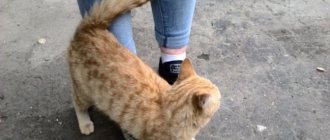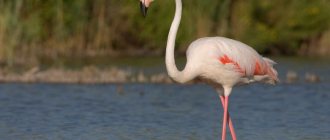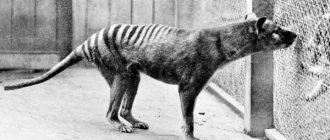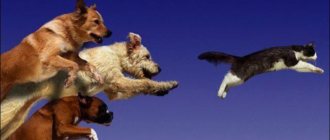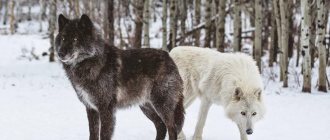- Wild animals
- >>
- Mammals
Ichthyostega is a genus of extinct animals closely related to tetrapods (four-legged land vertebrates). It is found as fossils in rocks in eastern Greenland from the late Devonian period about 370 million years ago. Although Ichthyostega is often called a "tetrapod" due to the presence of limbs and digits, it was a more basal "primitive" species than the true crown tetrapods and could more accurately be called a stegocephalic or stem tetrapod.
Origin of the species and description
Photo: Ichthyostega
Ichthyostega (from Greek "roof fish") is an early genus of the tetrapodomorphs clade that lived during the late Devonian period. It was one of the first four-limbed vertebrate species found in fossils. Ichthyostega had lungs and limbs that helped it move through shallow water in swamps. Based on its structure and habits, it is not considered a true member of the group, since the first modern amphibians (members of the Lissamphibia group) appeared in the Triassic period.
Video: Ichthyostega
Fun Fact: Four species were originally described, and a second genus, Ichthyostegopsis, was described. But further research revealed the existence of three valid species, based on the proportions of the skull and associated with three different formations.
Until the discovery of other early stegocephalians and closely related fishes in the late 20th century, Ichthyostega remained the only fossil found transitional between fish and tetrapods, combining both fish and tetrapod features. Newer research has shown that she had unusual anatomy.
Traditionally, Ichthyostega represents a paraphyletic class of the most primitive stem tetrapods, and therefore is not classified by many modern researchers as the ancestor of modern species. Phylogenetic analysis has demonstrated that Ichthyostega is an intermediate between other primitive stegocephalic stem tetrapods. In 2012, Schwartz compiled an evolutionary tree of early stegocephalians.
Classification [edit]
Traditionally Ichthyostega
was considered part of the order named after him, "Ichthyostegalia".
however, this group is a paraphyletic class of primitive stem tetrapods and is not used by many modern researchers. Phylogenetic analysis has shown that Ichthyostega
occupies an intermediate position between other primitive stegocephalic tetrapods. The evolutionary tree of early stegocephalians below follows the results of one such analysis by Schwartz in 2012 [6].
| Elpistostegalia | |
| Stegocephaly | |
| Elpistostege | |
| Crown group Tetrapoda | |
Appearance and features
Photo: What ichthyostega looks like
Ichthyostega was about one and a half meters long and had a small dorsal fin along the edge of the tail. The tail itself possessed a series of bony supports typical of the tail supports found in fish. Other characters retained in earlier aquatic vertebrates include a relatively short snout region, the presence of a preopercular bone in the cheek region that serves as part of the gills, and many small scales on the body. Advanced features characteristic of tetrapods include a series of strong bones supporting fleshy limbs, a lack of gills and strong ribs.
Interesting fact: Ichthyostega and its relatives represent forms somewhat more advanced than the aquatic Eusthenopteron, and appear to be close to the evolutionary line leading to the first tetrapods on land.
The most noticeable feature of the axial skeleton of Ichthyostega is the extent to which the ribs overlap each other. One pectoral rib may overlap three or four more posterior ones, forming a barrel-shaped “corset” around the body. This suggests that the animal could not bend its body laterally while walking or swimming. The vertebrae were not chordates, but the neural arches had more prominent zygapophyses.
It can be assumed that the animal moved more as a result of dorsoventral flexion than during normal lateral walking. The massive forelimbs may have been used to pull the animal forward and then flex the presacral region to pull up the hindquarters. The hind limbs consisted of a short, thick femur with a large flange and adductor deep intercondylar fossa.
The large, almost quadrangular tibia and shorter fibula were flattened. The greater intermediate and fibula included most of the ankle bones. A well-preserved example collected in 1987 shows a full set of seven fingers, three small ones at the leading edge and four full ones at the rear.
History[edit]
| In this section do not cite any sources . |
Reconstructed skull at the Geological Museum, Copenhagen
In 1932, Gunnar Save-Soderberg described four species of Ichthyostega
from the Late Devonian of East Greenland and one species belonging to the genus
Ichthyostegopsis
,
I. wimani
.
These species may be synonymous (in which case only I. stensioei
) since their morphological differences are not very pronounced. Species differ in skull proportions, skull punctuation, and skull bones. The comparison was made on 14 specimens collected in 1931 by the Danish East Greenland Expedition. Additional specimens were collected between 1933 and 1955. [5]
Where does Ichthyostega live?
Photo: Ichthyostega in water
Remains of Ichthyostegus have been found in Greenland. Although the exact habitat of the species is unknown, it can be assumed that Ichthyostegas were inhabitants of the northern hemisphere. And they inhabited the current waters of the Atlantic and Arctic Oceans. The Devonian period was characterized by a relatively warm climate and, probably, the absence of glaciers. The temperature differences from the equator to the poles were not as great as they are today. The weather was also very dry, mainly along the equator where the weather was driest.
Interesting fact: Reconstructions of tropical sea surface temperatures suggest a mean of 25°C in the Early Devonian. Carbon dioxide levels declined sharply during the Devonian period as the burial of newly formed forests pulled carbon from the atmosphere into the sediments. This is reflected in the mid-Devonian period by a cooling of temperatures to 5 °C. The Late Devonian is characterized by an increase in temperature to a level equivalent to the Early Devonian.
At that time, there is no corresponding increase in CO² concentrations, and continental weathering increases (as indicated by higher temperatures). In addition, a number of lines of evidence, such as plant distributions, point to late Devonian warming. It is during this period that the fossils found date back to this period. It is possible that Ichthyostegans persisted into the following Carboniferous period. Their further disappearance may be due to a decrease in temperature in their habitats.
During this period, climate affected the dominant organisms in the reefs, with microbes being the main reef-building organisms during warm periods and corals and stromatoporoid sponges playing a dominant role during colder times. Warming at the end of the Devonian may even have contributed to the extinction of stromatoporoids.
Now you know where ichthyostega was found. Let's see what she ate.
Further reading[edit]
- Blom, H (2005). "Taxonomic revision of the Late Devonian tetrapod Ichthyostega from East Greenland". Paleontology
.
48
(1):111–134. DOI: 10.1111/j.1475-4983.2004.00435.x. - Westenberg, K. (1999). "From flippers to feet." National Geographic
.
195
(5):114–127.
- Clack, J. A. (2012). Gaining Momentum: The Origin and Evolution of Tetrapods (2nd ed.). Bloomington, IN, USA: Indiana University Press. ISBN 9780253356758.
What did Ichthyostega eat?
Photo: Ichthyostega
Ichthyostega's fingers did not bend well, and the muscular system was weak, but the animal, in addition to the aquatic environment, could already move through swampy areas of land. If we consider the pastime of ichthyostega in percentage terms, then 70-80% of the time she conquered the water element, and the remaining time she tried to master the land. Its main sources of food were fish, marine plankton, and possibly marine plants that inhabited the seas of that time. Sea levels were generally high in the Devonian.
Marine faunas were still dominated by:
- bryozoans;
- diverse and abundant brachiopods;
- mysterious hederellids;
- microconchids;
- crinoids, lily-like animals, despite their resemblance to flowers, were abundant;
- trilobites were still quite common.
It is possible that Ichthyostega fed on some of these species. Previously, scientists associated Ichthyostega with the appearance of tetrapods on land. However, most likely, she went to land for a very short time and returned back to the water. Which of the ancient vertebrates became the true discoverer of land remains to be seen.
By the Devonian period, life was in full swing in the process of colonizing the earth. The moss forests and bacterial mats of the Silurian early in the period included primitive root plants, which created the original stable soils and arthropods such as mites, scorpions, trigonotarbids and millipedes. Although arthropods appeared on earth earlier than the Early Devonian, the existence of fossils such as Climactichnites suggests that terrestrial arthropods may have appeared as early as the Cambrian.
The first possible insect fossils appeared in the Early Devonian. Evidence for the earliest tetrapods comes in the form of trace fossils in shallow lagoons of a marine carbonate platform/shelf during the Middle Devonian, although these traces have been questioned and scientists have theorized fish feeding traces. All this rapidly developing flora and fauna was a potential food source for Ichthyostega.
Features of character and lifestyle
Photo: Extinct Ichthyostega
The animal's age was established at 370 million years and dated to the Devonian period. Ichthyostega is one of the oldest known tetrapods. Because of its features, which include characteristics of both fish and amphibians, Ichthyostega served as an important springboard and morphological evidence for the theory of evolution.
Fun Fact: One of the coolest facts about Ichthyostega is not that it had webbed feet, but that it was capable of breathing air—at least for short periods of time. However, even with this amazing ability, she probably didn't spend much time on land. This was because it was quite heavy and his legs were not strong enough to move his strong body.
Ichthyostega's forelimbs appear to have been heavy, and the forearm was unable to fully extend. The proportions of the elephant seal are the closest anatomical analogue among living animals. It is possible that Ichthyostega climbed onto rocky beaches, moving its forelimbs in parallel and dragging its hind limbs behind it.
The animal was incapable of typical quadrupedal gaits because the forelimbs did not have the necessary range of rotational motion. However, the exact lifestyle of Ichthyostega is not yet clear due to its unusual features.
Description[edit]
Size comparison
Ichthyostega
was a fairly large animal, broadly built and about 1.5 m (4.9 ft) long. The skull was flat, with eyes located on top and armed with large labyrinthodont teeth. The posterior edge of the skull forms the operculum covering the gills. The spiracle was located in the ear notch behind each eye.
The limbs were large compared to modern relatives, and it had seven digits on each hind limb. The exact number of fingers on the forelimb is not yet known, since fossils of the hand (arm) have not been found. [4] It had a fin on its tail containing fin rays. [5]
Ichthyostega
related to
Acanthostega gunnari
, also from East Greenland.
The skull of Ichthyostega
appears more fish-like than that of
Acanthostega
, but the morphology of its girdle (shoulder and hip) appears more robust and more adapted to life on land.
Ichthyostega
also had more supporting ribs and stronger vertebrae with more developed zygapophyses.
Whether these traits evolved independently in Ichthyostega
is controversial.
However, it shows that Ichthyostega
may have ventured onto land from time to time, unlike modern limbed vertebrates such as
Elginerpeton.
and
Obrucevictis
.
[ citation needed
]
Social structure and reproduction
Photo: Ichthyostegai
It is assumed that Ichthyostega and its relatives spent time basking in the sun to raise their body temperature. They also returned to the water to cool off, hunt for food, and reproduce. Their lifestyle required strong forelimbs to pull at least the front part out of the water, and a stronger rib cage and spine to support them while sunning their bellies, like modern crocodiles.
Interesting fact: Ichthyostegas became the progenitors of two main branches of amphibians, differing in the structure of the skull and limbs. In the Late Devonian, labyrinthodonts arose. Outwardly, they looked like crocodiles or salamanders. Today, hundreds of species of labyrinthodonts have become known, living in swampy forests and rivers.
Water was a requirement for Ichthyostega because the eggs of the earliest terrestrial tetrapods could not survive outside of water, so reproduction could not occur without an aquatic environment. Water was also necessary for their larvae and external fertilization. Since then, most land vertebrates have developed two methods of internal fertilization. Either direct, as seen in all amniotes and several amphibians, or indirect in many salamanders, placing the spermatophore on the ground, which is then picked up by the female.
Characteristics
Ichthyostegas were about 1.5 meters in length and had seven toes on their hind legs. The exact number of toes on the front paws has not yet been established, but it is likely that there were also seven of them. On the tail they had a “fish” type fin supported by the neural and haematal arches. The nostrils were located at the lower edge of the jaws. The lacrimal bone is adjacent to the nostril, but not to the orbit. The intertemporal bone is absent (this circumstance excludes the possibility of the origin of most temnospondyliids from this genus). The posterior thyme bone is odd. The jaw bone collides with the quadratofacial bone. The bones are preserved under the lid and in front. The nasal bones are wide. The eye sockets are oval and located in the central part of the skull. The notochord through the Slavoccipital part of the braincase reaches the pituitary fossa.
Natural enemies of Ichthyostega
Photo: What ichthyostega looks like
Although the forelimbs were not recovered because they are not found among known fossils of the animal, it is believed that these appendages were larger than the animal's hind limbs. Scientists believe that in this way Ichthyostega moved its body from water to land.
It appears that locomotion, a function of instinctive movements of the body's musculoskeletal system, represented only minimal variability in movement underwater through a combination of tail and leg movements. In this case, the legs were specifically used to move muscles through the flooded undergrowth of aquatic plants.
Interesting fact: Although terrestrial movements were possible, Ichthyostega was more developed for life in water, especially during the adult stage of its life. It rarely moved on land, and perhaps the smaller size of juveniles, allowing them to move more easily on land, served not to search for food outside the water element, but as a way to avoid other large predators until they grew large enough to not become their prey.
Scientists argue that moving onto land provided the animals with greater safety from predators, less competition for prey, and certain ecological benefits not found in water, such as oxygen concentration and temperature control—implying that developing limbs also adapted to carry out part of his time out of the water.
However, research has shown that sarcopterygians evolved quadruped-like limbs suitable for walking well before venturing onto land. This suggests that they adapted to walk on land underwater before moving onto land.
Links[edit]
- Haaramo, Mikko. "Taxonomic history of the genus †Ichthyostega Säve-Söderbergh, 1932". Mikko Phylogeny Archive
. Blom, 2005. Retrieved October 24, 2015. - "Ichthyostega". Paleofile
. Retrieved October 24, 2015. - ^ abc Stephanie E. Pierce; Jennifer A. Clack; John R. Hutchinson (2012). "Three-dimensional limb joint mobility in the early tetrapod Ichthyostega
".
Nature
.
486
(7404):524–527. DOI: 10.1038/nature11124. PMID 22722854. - Evolutionary Developmental Biology
, Brian Keith Hall, 1998, ISBN 0-412-78580-3, p. 262 - ^ ab Jarvik, Eric (April 15, 1996). "The Devonian tetrapod Ichthyostega" (PDF). Fossils and strata
.
40
: 1–206. - Swartz, B. (2012). "A marine stem tetrapod from the Devonian of Western North America". PLoS ONE
.
7
(3):e33683. DOI: 10.1371/journal.pone.0033683. PMC 3308997. PMID 22448265. - Devonian Times - The Answer of Quadrupeds
- ↑
Williams, James J. (24 May 2012). "Ichthyostega, one of the first creatures to walk on land, could not walk on four legs, scientists say". BelleNews. Retrieved November 4, 2013. - ↑
Mosher, Dave (May 23, 2012). "Evolutionary Failure: Did the Early Quadruped Land Animal Walk?" . National Geographic News. Retrieved November 4, 2013.
